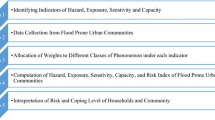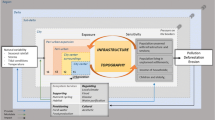Abstract
Many coastal cities in developing countries are at the risk of flooding due to a progressive increase in the built-up areas and poor management of storm water. The flooding situation in coastal cities gets accentuated further due to climate-induced natural disasters such as cyclones and climate change-induced sea-level rise that adversely impact the city's natural drainage potential. This study developed a composite urban flood risk index consisting of three sub-indices and 20 key natural, physical, social, and economic influencing variables for a coastal city (i.e., Cuttack) in eastern India, the intensity of storm run-off being one among the many. The intensity–duration–frequency curve developed shows that the city can experience floods with a peak discharge of 1320 cubic metre per second every alternate year for a rainfall intensity of 2-h duration. The urban flood risk index computed for all the city wards shows that out of the 59 wards, only one ward has low flood risk (index value < 0.40) and 20 wards are at high risk (index value 0.55 and above) from the urban flood. Thereafter, factors leading to high risk due to urban floods were identified and the institutional capacities available with the urban utility for fighting floods analysed.

(Source: Developed by authors)

(Source: Authors analysis using data set from the Indian Meteorological Department and the website of Special Relief Commissioner, Govt. of Odisha)

(Source: Authors own analysis)

(Source: Authors own analysis)

(Source: Authors' computation)

(Source: Authors own analysis)

(Source: Authors own analysis)

(Source: Authors own analysis)

(Source: Authors own analysis)

(Source: Authors own analysis)

(Source: Authors own analysis)

(Source: Authors own analysis)

(Source: Based on the Government of Malaysia 2011)
Similar content being viewed by others
References
Andimuthu R, Kandasamy P, Mudgal BV, Jeganathan A, Balu A, Sankar G (2019) Performance of urban storm drainage network under changing climate scenarios: Flood mitigation in Indian coastal city. Sci Rep 9(1):1–10
Brecht H, Dasgupta S, Laplante B, Murray S, Wheeler D (2012) Sea-level rise and storm surges: high stakes for a small number of developing countries. J Environ Dev 21(1):120–138
Chow VT, Maidment DR, Mays LW (2013) Applied Hydrology, 7th edn. Tata McGraw-Hill Education, India
Chowdhury RK, Alam MJ, Das P, Alam MA (2007) Short duration rainfall estimation of Sylhet: IMD and USWB method. J Indian Water Works Assoc 39(4):285–292
Cuttack Municipal Corporation (CMC) (2020) City disaster management plan, Cuttack city 2019–2020. CMC, Government of Odisha, India
Daniela R, Marco V (2017) Land use and landscape pattern changes driven by land reclamation in a coastal area: the case of Volturno delta plain, Campania Region, southern Italy. Environ Earth Sci 76(20):1–19
Douben KJ (2006) Characteristics of river floods and flooding: a global overview, 1985–2003. Irrig Drain 55(S1):S9–S21
Government of India (GoI) (2011) Census of India. Office of the Registrar General and Census Commissioner, Ministry of Home Affairs, Delhi, India
Government of Malaysia (2011) Urban stormwater management manual for Malaysia, MSMA 2nd Edition. Department of Irrigation and Drainage, Government of Malaysia
Hammond MJ, Chen AS, Djordjević S, Butler D, Mark O (2015) Urban flood impact assessment: A state-of-the-art review. Urban Water J 12(1):14–29
Hanson S, Nicholls R, Ranger N, Hallegatte S, Corfee-Morlot J, Herweijer C, Chateau J (2011) A global ranking of port cities with high exposure to climate extremes. Clim Change 104(1):89–111
IPCC (2014) Technical summary. Climate change 2014: Impacts, adaptation, and vulnerability, part A: Global and sectoral aspects. Contribution of Working Group II to the Fifth Assessment Report of the Intergovernmental Panel on Climate Change. Cambridge University Press, UK and USA, pp 35–94
IRAP and UNICEF (2017) Capacity building for planning of climate-resilient WASH services in rural Maharashtra. Final Report Submitted to UNICEF Field office, Mumbai. Institute for Resource Analysis and Policy, Hyderabad, India
IRAP and UNICEF (2017) Mapping of climate risk in the WASH sector of Rajasthan. Final Report Submitted to UNICEF Field office, Jaipur. Institute for Resource Analysis and Policy, Hyderabad, India
IRAP, GSDA, & UNICEF (2013) Multiple-Use water services to reduce poverty and vulnerability to climate variability and change-A collaborative action research project in Maharashtra, India. Final report submitted to UNICEF Field office, Mumbai. Institute for Resource Analysis and Policy, Hyderabad, India
Jongman B, Ward PJ, Aerts JC (2012) Global exposure to river and coastal flooding: Long term trends and changes. Glob Environ Chang 22(4):823–835
Kabir Y, Bassi N, Kumar MD, Niranjan V (2016) Multiple-Use water systems for reducing household vulnerability to water supply problems. In: Kumar MD, James AJ, Kabir Y (eds) Rural water systems for multiple uses and livelihood security. Elsevier, Netherlands, pp 69–78
Kirpich ZP (1940) Time of concentration of small agricultural watersheds. Civ Eng 10(6):362
Krysanova V, Buiteveld H, Haase D, Hattermann FF, van Niekerk K, Roest K, Martınez-Santos P, Schluter M (2008) Practices and lessons learned in coping with climatic hazards at the river-basin scale: floods and droughts. Ecol Soc 13(2):32
Kumar MD, Ganguly A, Kabir Y, Khare O (2021) A framework for assessing climate-induced risk for water supply, sanitation and hygiene. In: Kumar MD, Kabir Y, Hemani R, Bassi N (eds) Management of irrigation and water supply under climatic extremes: empirical analysis and policy lessons from India. Springer Nature, Switzerland, pp 179–207
Kumar MD, Bassi N, Kumar S, Kar D (2020) Storm water management plan of Cuttack city, Odisha. Report prepared for the USAID-MHA-UNDP Partnership on Developing Resilient Cities through Risk Reduction in the context of Disaster and Climate Change. Institute for Resource Analysis and Policy, Hyderabad, India
Li C, Cheng X, Li N, Du X, Yu Q, Kan G (2016) A framework for flood risk analysis and benefit assessment of flood control measures in urban areas. Int J Environ Res Public Health 13(8):787
Marfai MA, King L (2008) Potential vulnerability implications of coastal inundation due to sea level rise for the coastal zone of Semarang city. Indones Environ Geol 54(6):1235–1245
Mauro MD (2014) Quantifying risk before disasters occur: hazard information for probabilistic risk assessment, Bulletin Vol 63 (2). Risk Knowledge Section, United Nations Office for Disaster Risk Reduction (UNISDR), Geneva, Switzerland
Messner F, Meyer V (2006) Flood damage, vulnerability and risk perception–challenges for flood damage research. Flood risk management: hazards, vulnerability and mitigation measures. Springer, Dordrecht, pp 149–167
Namitha MR, Vinothkumar V (2019) Derivation of the Intensity-Duration-Frequency curve for annual maxima rainfall using generalised extreme value distribution. Int J Curr Microbiol Appl Sci 8(1):2626–2632
National Disaster Management Authority (NDMA) (2010) National disaster management guidelines: management of urban flooding. NDMA, Government of India, Delhi
National Remote Sensing Centre (NRSC) (2019) Flood hazard zonation atlas, Odisha: A geospatial approach. NRSC, Indian Space Research Organisation, Department of Space, Government of India
Papageorgiou M (2016) Coastal and marine tourism: a challenging factor in marine spatial planning. Ocean Coast Manag 129:44–48
Patankar AM (2015) The exposure, vulnerability, and ability to respond of poor households to recurrent floods in Mumbai, Policy Research Working Paper no. 7481. World Bank, Washington, DC
Rani NS, Satyanarayana ANV, Bhaskaran PK (2015) Coastal vulnerability assessment studies over India: a review. Nat Hazards 77(1):405–428
Rathnam EV, Jayakumar KV, Cunnane C (2001) Runoff computation in a data scarce environment for urban stormwater management-a case study. In: Proceedings of the congress of the international association for hydraulic research. Beijing, China, pp 446–454
Rodríguez-Iturbe I, Devoto G, Valdés JB (1979) Discharge response analysis and hydrologic similarity: the interrelation between the geomorphologic IUH and the storm characteristics. Water Resour Res 15(6):1435–1444
Saini SS, Kaushik SP (2012) Risk and vulnerability assessment of flood hazard in part of Ghaggar Basin: A case study of Guhla block, Kaithal, Haryana, India. Int J Geom Geosci 3(1):42–54
Samonte-Tan GP, White AT, Tercero MA, Diviva J, Tabara E, Caballes C (2007) Economic valuation of coastal and marine resources: Bohol Marine Triangle. Philipp Coast Manage 35(2–3):319–338
Sanyal J, Lu XX (2006) GIS-based flood hazard mapping at different administrative scales: a case study in Gangetic West Bengal, India. Singap J Trop Geogr 27(2):207–220
Saxena S, Purvaja R, Suganya GMD, Ramesh R (2013) Coastal hazard mapping in the Cuddalore region. South India Nat Hazards 66(3):1519–1536
Schanze J (2006) Flood risk management–a basic framework. In: Schanze J, Zeman E, Marsalek J (eds) Flood risk management: hazards, vulnerability and mitigation measures. Springer, Dordrecht, Netherlands, pp 1–20
Shoaf KI, Rotiman SJ (2000) Public health impact of disasters. Aust J Emerg Manage 15(3):58–63
Singh P, Sinha VSP, Vijhani A, Pahuja N (2018) Vulnerability assessment of urban road network from urban flood. Int J Disaster Risk Reduct 28:237–250
Small C, Nicholls RJ (2003) A global analysis of human settlement in coastal zones. J Coastal Res 19(3):584–599
Tibbetts J (2002) Coastal cities: living on the edge. Environ Health Perspect 110(11):A674–A681
Vitousek S, Barnard PL, Fletcher CH, Frazer N, Erikson L, Storlazzi CD (2017) Doubling of coastal flooding frequency within decades due to sea-level rise. Sci Rep 7(1):1–9
Funding
This paper is based on a research study that received financial support under the USAID, the Ministry of Home Affairs (Government of India), and the UNDP partnership 'Developing Resilient Cities through Risk Reduction in the context of Disaster and Climate Change'.
Author information
Authors and Affiliations
Contributions
The research was conceptualised by Dr. M. Dinesh Kumar and Mr. Manish Mohandas. Dr. M. Dinesh Kumar and Mr. Nitin Bassi developed the methodology for the study. Data collection was undertaken by Dr. Saurabh Kumar and coordinated by Mr. Pradipta Kumar Mohanty. Data were analysed by Mr. Nitin Bassi. All authors contributed equally to the writing of the paper.
Corresponding author
Ethics declarations
Conflict of interest
There is no conflict of interest.
Additional information
Publisher's Note
Springer Nature remains neutral with regard to jurisdictional claims in published maps and institutional affiliations.
Rights and permissions
About this article
Cite this article
Kumar, M.D., Tandon, S., Bassi, N. et al. A framework for risk-based assessment of urban floods in coastal cities. Nat Hazards 110, 2035–2057 (2022). https://doi.org/10.1007/s11069-021-05024-w
Received:
Accepted:
Published:
Issue Date:
DOI: https://doi.org/10.1007/s11069-021-05024-w




